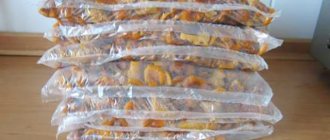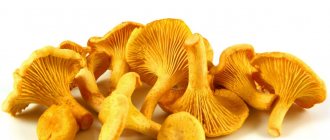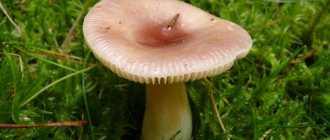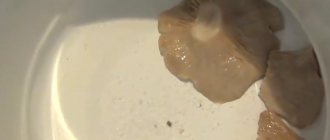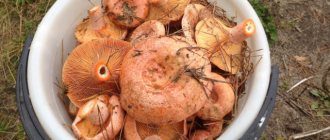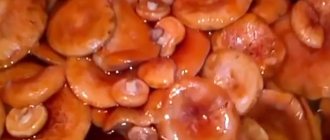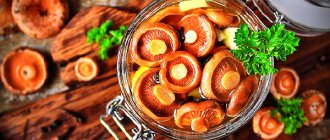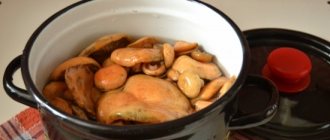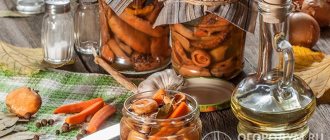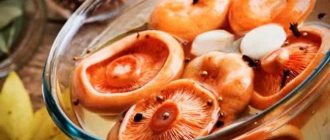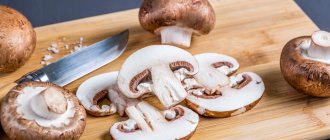Ryzhiki are called royal mushrooms for their incomparable taste and aroma, as well as for the fact that when salted they require neither soaking nor heat treatment. Therefore, saffron milk caps are most often prepared for the winter using pickling. Nevertheless, many housewives are faced with a situation where everything seems to have been done correctly and according to the recipe, but the saffron milk caps have turned sour. What this means, what reasons can lead to souring, and what can be done about it will be discussed further.
How to salt milk mushrooms so that they do not darken?
What can I do to prevent milk mushrooms from turning black when cooked?
- Water is poured into the mushrooms, salted and enough acid is added so that the water becomes slightly sour.
- After 15 minutes, the liquid is drained and the milk mushrooms are boiled in plain water, without adding salt or citric acid.
Interesting materials:
Where to submit documents for maternity capital? Where to apply for a residence permit? Where to apply for a passport in Kharkov? Where to apply for a passport? Where to apply for a patent? Where to submit documents for temporary residence permit? Where to apply for a passport? Where is the document index indicated on the receipt? Where in Moscow to apply for Russian citizenship? Green card when to apply?
Why did saffron milk caps ferment?
Saffron milk caps can ferment for a variety of reasons. It also happens that the signs of normal fermentation, which can be considered standard when pickling saffron milk caps, are mistaken by many novice housewives for dangerous symptoms. So, if after several days of being under pressure a thin strip of mold appears on the surface of the mushrooms, then you should not worry too much. This is an almost normal process that occurs due to contact with oxygen in the air. And in any recipe that describes salting saffron milk caps in a cold way, it must be stated that during the period of fermentation under pressure (3-5 weeks), once every 2-3 days, the fabric covering the mushrooms and the press itself must be washed. It's best to boil them in a little water or even use a new cloth.
A similar situation can happen when it seems that saffron milk mushrooms have fermented in the jars where they were transferred after a short stay under oppression. If the fermentation process has not finished (and it needs from 2 to 6 weeks, depending on the temperature), then bubbles may appear on the surface of the brine, and the brine itself will begin to slowly flow out of loosely covered jars. This is completely normal. You just need to strictly follow the instructions for how long the salted saffron milk caps should be kept under pressure. Here it is important to check whether the mushrooms have soured or not. In the first case, it is necessary to take effective measures. If the taste of the brine has not changed, then the mushrooms are quite edible, and you just need to wait.
But often the situation arises that you have to keep jars of saffron milk caps that have not yet fermented in the refrigerator, since it is difficult to find another equally cold place. In this case, the jars should be placed in additional containers or in thick plastic bags so as not to stain the refrigerator shelves. But sooner or later (on average after 3-4 weeks) the fermentation process will stop and you can loosen control over the salted mushrooms and no longer be afraid that they will turn sour.
It’s another matter if salted saffron milk caps turn sour due to non-compliance with certain preparation or storage rules.
Many housewives, by inertia, like to soak mushrooms in water before salting. After all, this procedure is required by all types of milk mushrooms, and other lamellar mushrooms. But saffron milk caps have a very negative attitude towards this procedure. They belong to category 1 edible mushrooms and do not need soaking at all. It’s not for nothing that the best classic method of salting saffron milk caps is dry, that is, without access to water at all. Therefore, if the saffron milk caps turn sour during salting, then you need, first of all, to remember whether they were left in the water unattended for some time. This could negatively affect their structure and lead to subsequent souring.
In the process of salting saffron milk caps, it is imperative to use oppression. Since it is this that helps to constantly keep the mushrooms under the surface of the brine. If some parts of the mushrooms are not immersed in brine, the likelihood that they will turn sour and mold will appear will increase many times over. Most often, only the oppression itself sticks out of the brine. Since it comes into contact with the camelina brine and air at the same time, it is for this reason that it must be periodically removed and thoroughly washed with hot water so that the mushrooms do not sour. This factor is especially important when using cold and dry salting.
Comment! To salt saffron milk caps in a jar, you can use plastic bags filled with water as pressure.
Finally, the appropriate air temperature and lighting conditions under which salting and subsequent storage of saffron milk caps occur are very important. When light hits containers with mushrooms, they can easily turn sour. The same thing happens when the storage temperature increases above + 6 °C.
Important! You cannot roll up salted saffron milk caps with airtight metal lids for storage. There is a very high risk of developing botulism.
Edible - inedible
All mushrooms are divided into edible, conditionally edible, poisonous and inedible.
Edible mushrooms are those whose fruiting bodies do not contain bitterness, harmful substances or unpleasant odor. They can be eaten immediately after collecting, cleaning and washing, without preliminary preparation, but it is still better to subject them to heat treatment: boiling, frying, etc. Edible mushrooms are not the same in structure, they are divided into spongy - white, boletus, boletus, boletus and lamellar – champignons, russula, chanterelles, honey mushrooms.
How to tell if canned mushrooms have gone sour
As for how to identify a sour twist with mushrooms, everything is a little simpler here. At the initial stages, as a rule, no signs of damage are observed, but later they become quite bright.
- Usually, a swollen lid and cloudy marinade indicate that the product has soured.
- Foam forms in the upper part of the workpiece, which subsequently turns into mold and grows first at the top and then falls below. E
- Another sign of a spoiled product is an unpleasant sour smell emanating from the contents of the jar. But to find it, the container will have to be opened.
If you think the twist has gone bad, get rid of it immediately, as eating such a product will inevitably lead to severe food poisoning.
How to tell if canned mushrooms have gone sour
More ways to pickle milk mushrooms
Dry salting of milk mushrooms
Ingredients:
- Milk mushrooms – 10 kg
- salt – 500 g.
Peel and disassemble the mushrooms, cut off the stem, place in a wooden barrel, sprinkle with salt, cover with a napkin, place a circle and a weight on top. Pickled mushrooms, separating their juice, noticeably thicken. As they settle, you can add fresh triba, sprinkling them with salt until the dish is full and the settling stops. Mushrooms are ready to eat after 35 days.
Salting boiled milk mushrooms
For 10 kg of boiled milk mushrooms:
- 450–600 g salt
- garlic
- onion
- horseradish
- tarragon or dill stems
Clean and washed mushrooms are boiled in lightly salted water. The cooking time depends on the type of mushroom. Cool in cold water. Allow the water to drain on a sieve. Then the mushrooms are placed in a barrel, mixed with salt, covered with a cloth and a lid with pressure. After a few days, the mushrooms will settle and you need to add more mushrooms with the appropriate amount of salt.
Seasonings are placed at the bottom of the dish or mixed with mushrooms. After a week they become suitable for consumption. The brine must completely cover the mushrooms throughout the storage period to avoid mold. If there is not enough brine and it does not cover the mushrooms, you should add chilled salted boiled water (take 50 g, i.e. 2 tablespoons of salt per 1 liter of water). During storage, mushrooms should be checked from time to time and mold should be removed. The lid, oppression stone and fabric are washed from mold in soda water and boiled, the inner edge of the dish is wiped with a napkin moistened with a solution of salt or vinegar.
Salting milk mushrooms and milk mushrooms in Altai style
Ingredients:
- mushrooms – 10 kg
- dill greens – 35 g
- horseradish root – 20 g
- garlic – 40 g
- allspice – 35–40 peas
- bay leaf – 10 sheets
- salt – 400 g.
The mushrooms are sorted, cleaned, the stalk is cut off and soaked in cold water for 2-3 days. The water is changed at least once a day. Then the mushrooms are thrown onto a sieve and placed in a barrel, layered with spices and salt. Cover with a napkin, place a circle and a weight. Brine should appear above the circle. If the brine does not appear within 2 days, it is necessary to increase the load. The barrel is filled with new mushrooms, as the volume of mushrooms gradually decreases by one third. After 20 days, the mushrooms are ready to eat.
Salted blanched milk mushrooms
Ingredients:
- 10 kg mushrooms
- 400–500 g salt (2–2.5 cups)
- garlic
- parsley
- horseradish leaves
- stalks of dill or celery
Blanch the peeled and washed mushrooms. To do this, put them in a colander, pour plenty of boiling water over them, steam them or put them in boiling water for a short time so that the mushrooms become elastic and not brittle. Then cool quickly by pouring cold water. Place in a colander and let the water drain. Place in a prepared wooden tub in layers, sprinkling each layer with salt and topping with garlic, parsley, horseradish leaves, dill and celery. After 3–4 days, the blanched mushrooms are salted and ready for consumption.
Proven Recipes
We figured out how and for how long to cook boletus mushrooms in order to prepare a great dish from them that can please not only them, but also all the guests. And considering that its calorie content is very high (22 kcal per 100 g of fresh product), any dish with their addition becomes very desirable for guests and household members.
First recipe: boletus soup
You will need:
- 300 grams of boletus;
- 2 tbsp. l. semolina;
- 2 l. water;
- 1 bunch of dill;
- 3 tbsp. l. butter (sunflower, butter);
- 2 pcs. chicken eggs;
- 4 tbsp. l. sour cream.
- Peel the mushrooms, slice and rinse;
- Fry them for 25 minutes. in a well-heated frying pan with a lid;
- Carefully pour the semolina into the frying pan and fry them for another 10 minutes, stirring;
- Boil chicken eggs hard and cut into small pieces;
- Add the contents of the frying pan to boiling water and cook for 10 minutes.
Serve the dish with dill and sour cream.
Second recipe: cheese soup with mushrooms
We will need the following ingredients for a three-liter pan:
- 300 grams of Druzhba cheese;
- 200 grams of boletus (can be frozen);
- 4 potatoes;
- 1 carrot;
- 100 g leeks;
- 2 liters of water;
- salt, pepper, dill - to taste.
- Wash the mushrooms, peel and cut into pieces;
- Place the boletus into boiling water and cook for 15 minutes, removing the foam;
- Wash and peel the potatoes and carrots;
- Chop the potatoes into cubes and coarsely grate the carrots;
- Add potatoes to the broth and continue cooking;
- In 10 minutes. after adding the potatoes, add the carrots and onions, cook for another 10 minutes;
- At the end of cooking, add spices to taste and cheese;
- Stir the cheese until it dissolves and cook for another 10 minutes.
Third recipe: fried potatoes with boiled boletus
You will need:
- 500 g of the main component;
- 500 grams of potatoes;
- 1 onion;
- spices to taste.
- Place peeled and washed fresh mushrooms in a saucepan, add water and bring to a boil over medium heat.
- Add 3 g of citric acid and 20 g of salt for every liter of water in the pan.
- Cook for 5 minutes, then drain them in a colander and dry.
- Place in a preheated frying pan and fry for about 40 minutes, stirring occasionally.
- Now you can salt the mushrooms, but if you do this at the very beginning, they will be too dry.
- In a separate pan, fry potatoes and onions.
- Mix vegetables with mushrooms and let stand covered for a while.
You can serve the dish with herbs, a variety of sauces and homemade pickles.
Few people know how to identify poisonous mushrooms when cooking.
In addition, few people know that they cannot be 100% classified as plants, since they contain signs of the animal world too. There are about 1.5 million species, subspecies and varieties of mushrooms in nature. This figure is a bit approximate, since scientists and avid mushroom pickers are discovering more and more new specimens. Science does not have an exact number of edible and poisonous mushrooms. It is believed that their percentage is 50/50, that is, they are equally divided.
Poisonous mushrooms can also be identified at the cooking stage.
This product is a common and favorite dish of many. In some national cuisines this product occupies a special, privileged place. Mushrooms can be pickled, salted, dried, served fried or boiled. There are a lot of recipes with this delicacy. Food with them acquires an extraordinary, unforgettable taste, and dishes decorated with this dish are a delight to the eye on any holiday table.
Collecting the right mushrooms
Many edible and conditionally edible mushrooms have poisonous analogues, or false mushrooms - false honey mushrooms, false chanterelles, boletus, champignons, and even false porcini mushrooms, considered royal.
It will not be possible to remove the bitterness from them even after long-term processing; moreover, in addition to the bitterness, they will also contain poisons that are dangerous to humans, so you need to collect only those mushrooms whose quality is beyond doubt.
For example, gall mushroom, or bitterling, is not edible, although in appearance it can easily be mistaken for boletus, boletus or porcini mushroom. Cooking bitters only enhances the bitterness.
Experienced mushroom pickers warn that even one poisonous and bitter mushroom can ruin the entire dish; its bitterness is enough for everyone. Therefore, it is better to check mushrooms in the forest. Poisonous analogues of edible mushrooms look brighter and more beautiful than non-poisonous ones. They are rarely eaten by worms, snails and insects, but that's not all - when cut, the poisonous mushroom turns blue, while its edible counterpart turns red.
Bitterness is noted in milk mushrooms - milk mushrooms, travelers, chanterelles, volnushki, podtopolniks, white mushrooms, valuevs and some other edible mushrooms.
Mushrooms collected in coniferous forests are more bitter than mushrooms from deciduous forests, even if they belong to the same species and family. In addition, “coniferous” mushrooms have a resinous aftertaste that is not so easy to remove.
Another reason for bitterness in edible mushrooms is lack of moisture. Immediately after rain, mushrooms are tasty, but after a week, due to the heat, their taste can change greatly for the worse. Due to lack of moisture, they become bitter or bilious.
Mushrooms will be bitter in polluted areas; everyone knows that they, like a sponge, absorb everything that is in the air, soil and water. You cannot even collect edible mushrooms growing along roads, near large industrial enterprises, landfills and other pollutants. You only need to cut mushrooms with a stainless steel knife or a ceramic knife.
Some mushrooms are naturally bitter!
What to do with saffron milk caps if they are sour
If, after all, the salted saffron milk caps have turned sour after the end of the fermentation period, then you can do the following with the mushrooms:
- Remove them from the container, rinse under running water and place in a pan of boiling water, to which 30 g of salt and 5 g of citric acid are added per 1 liter of water used.
- Drain all the previous liquid, rinse the container thoroughly with soda and rinse with boiling water.
- Boil the saffron milk caps for about 7-10 minutes, then place in a colander and allow excess liquid to drain.
- Prepare fresh brine by dissolving 1 tablespoon of rock salt in 1 liter of water.
- Place ½ tsp in a sterilized jar. mustard seeds, place mushrooms on top and pour fresh brine.
The taste of salted saffron milk caps will change slightly from the addition of mustard, but will not spoil the overall picture.
By the way, when looking for an answer to the question of what to do with pickled saffron milk caps if they have fermented, you can use the same advice. You just need to fill them with fresh marinade, to which for preservation it is better to add a little more vinegar.
Checking conservation for botulism
The bacterium clostridium, which causes the accumulation of toxin, subsequent poisoning and the disease botulism, initially develops and lives in soil and water, as well as in humus and moss, which are abundant in mushroom areas. Therefore, the mushroom picker runs the risk of bringing home an already infected crop. If the mushroom is not thoroughly cleaned of leaves and dirt, then the bacteria will remain on the surface of the product and get into the workpiece, and from there into the food. An insufficiently purified product placed in jars for curing or barrels for pickling poses a real danger of poisoning.
The following signs will help identify botulism and other infections in mushrooms:
- a jar with a cloudy marinade, and the mucus can lie with the brine in layers, accumulate, or completely cover the walls of the jar;
- a jar with bubbles rising from the bottom indicates an intense fermentation process with the release of gases;
- a swollen lid that seems to “explode” when opened.
If your canned food contains any of the above symptoms, you should immediately throw it away. Such preserves cannot be eaten, cooked from, or stored. Even if there is no botulism in mushrooms, they may contain other dangerous substances, which in any case will lead to severe food poisoning. Therefore, it is better to eliminate all preserved food so that family members do not get poisoned.
Bacteria will not develop in hermetically sealed containers only if the temperature at the storage location is kept below +3ºС
It is worth noting that it is impossible to reliably test for botulism by taking into account only the color and taste. Laboratory analysis is considered the only true and accurate way to determine the type of bacteria that have spoiled the mushrooms.
Rules for the prevention of mushroom poisoning
- Collect only those mushrooms in the forest that you know for sure are edible.
- Do not pick mushrooms along roads and railways, because... they accumulate toxic substances that make them unfit for consumption.
- Never eat overripe, wormy, sour mushrooms or their parts, as it is not always possible to tell from them whether they are edible or false, and it is also difficult to determine when they were collected.
- Be sure to boil or soak mushrooms, milk mushrooms and other mushrooms containing milky juice before pickling to remove bitter substances that irritate the stomach.
- You cannot buy and prepare a mixture of different types of mushrooms, mushrooms without legs, since the mushroom assortment may contain mushrooms with milky, bitter juice, which must first be soaked, in which case the mushroom dish will be spoiled.
- You cannot buy mushrooms on the street or from random people. In private markets, mushrooms are most likely not checked, but in public markets, trade in only cultivated mushrooms, such as champignons, is allowed.
- It is necessary to trample or destroy myceliums in places where children walk in the territory of kindergartens, forests and summer cottages.
[1] The largest children's toxicology center in Moscow is located in the children's city clinical hospital No. 13 named after. N.F. Filatova.
Fly agarics contain the toxins muscarine and muscaridine. Poisoning with these poisons manifests itself after 0.5–2 hours, sometimes after 10 hours. Signs of poisoning: nausea, vomiting, thirst, profuse sweating, weakness. Sometimes dizziness, delirium, hallucinations, rare pulse, shortness of breath, and convulsions appear.
The salted mushrooms have gone bad. Do sour pickled mushrooms pose a health hazard?
Each of us is familiar with food poisoning - most often it occurs when stale or spoiled foods are eaten. They usually disrupt the normal functioning of the digestive system for a short time and do not have any serious health consequences.
When it comes to canned goods and twists, food poisoning can cause quite dangerous problems. First of all, we are talking about botulism, an infection that often ends in death.
As you know, mushrooms grow directly on the ground, and therefore its particles quite often remain on their surface. It is in the soil that botulinum bacteria are most often found, which cause acute digestive infections.
Of course, before making the twists, the mushrooms must be washed, soaked and cleaned, but this is not enough. The fact is that microscopic particles of earth still remain on the mushrooms, and along with them, pathogenic bacteria may also be present.
These bacteria die during prolonged heat treatment, but this does not always happen. In the presence of suitable conditions - a comfortable temperature and the absence of oxygen, bacteria produce toxins, which pose the main danger to human health. In fact, canned mushrooms are an ideal environment for the development of this type of bacteria.
